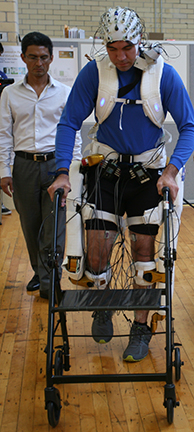The Institute for Rehabilitation and Research (TIRR) Foundation, a nonprofit organization devoted to improving the lives of patients with central nervous system damage, awarded Jose “Pepe” Contreras-Vidal, professor of electrical and computer engineering at UH Cullen College, a $100,000 Mission Connect grant earlier this month.
The award supports investigation of the long-term performance of a brain-machine interface, BMI, with a powered robotic exoskeleton, REX, for individuals with spinal cord injuries, SCI. Specifically, Contreras-Vidal plans to assess the multi-session stability and anatomical sources of EEG signals in SCI patients. The study can also provide fundamental knowledge about brain adaptations triggered by prolonged BMI-REX use.
“Importantly, this project will create a set of basic open-source, platform-independent, neurorobotic interface technologies for designing and validating wearable robot systems that use BMI systems for command and control by patients with paralysis who cannot use crutches or walkers for stabilization,” Contreras-Vidal said.
Also working on the project are Atilla Kilicarslan, research associate in the UH Laboratory for Noninvasive Brain-Machine Interface Systems, and Methodist Research Institute collaborators, Robert Grossman and Christoph Karmonik.
Established in 1997, Mission Connect, a collaborative neurotrauma research project, supports efforts to prevent, treat and cure central nervous system damage caused by brain injuries, spinal cord injuries and neurodegenerative diseases, according to the TIRR website. The foundation considers the pursuit of basic research essential to a fundamental understanding of the human central nervous system, and consequently, the growth of applied science. The organization provides scientists in various areas of neurobiology research with a collaborative environment to accelerate the pace of their work. Finally, funding is awarded to the best and brightest scientists with the most promising exploratory studies often considered too risky or emergent to attract federal funding. Mission Connect gives them an opportunity to compile preliminary data so they can apply for additional funding from major donors.
“The research investments made by Mission Connect have been highly successful,” according to the foundation website. “Since 1997, every dollar invested by Mission Connect has been leveraged five to one by the scientists from NIH grants, DOD grants and other large funding sources.”
